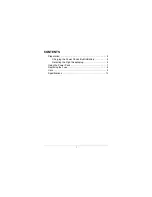
FireSwitch108
- 15 -
3. Combination CO and Fire Alarm Connections:
To comply with requirements of applicable UL
and NFPA standards Fire Systems (UL 864), CAN/
ULC-S527-99 Control units for Fire Alarm Systems,
NFPA 72, and NFPA 720 audible and visual notifica-
tion appliances have to be used on different circuits .
Systems has to be monitored by a supervising station
and emergency response provided in accordance with
NFPA 720 .
For CO Alarms, the system must be monitored
by a supervising station with emergency response.
CO combination mode settings are not accessible
through IP interface . In CO alarm mode the unit will
indicate CO alarm which will be superseded by fire
alarm, if fire alarm is initiated . In order for CO alarm
mode to operate, horns and strobes have to be wired
separately . The outputs for strobes should be pro-
grammed for 1e mode . The outputs for horns should
be programmed for 2e mode . FACP has to initiate out-
put 2 only during CO alarm and Output 1 and Output
2 during fire alarm condition .
To silence the horns during fire alarm condition
Output 2 has to be turned off, but Output 1 has to stay on .
During CO alarm (Input 2 initiated only) horns will generate CO alert sequence (Temporal 4 pattern) and
strobes will flash every second . During fire alarm condition (Input 1 only or Inputs 1 and 2) strobes will flash
and horns will generate Temporal3 pattern, unless silenced .
Programming and LCD Legend:
LCD Legend
Description
1e
Generates strobe sync signal
2e
Generates T3 horn temporal pattern
or T4 temporal pattern (see above) .
Horn settings for CO alarm:
Gentex, Potter - Horns must be set to Steady mode .
System Sensor - Horns must be set for a coded output .
4. Non-Synchronizable NAC Appliances:
When using NAC appliances not designed to sup-
port synchronization feature, it is recommended to
use separate output circuits for audible notification
appliances (horns) and visual notification appliances
(strobes) .
Program the FireSwitch to follow Input 1 [IN1] and
for audible notification appliances to follow Input 2
[IN2] . This will allow, when using two (2) outputs
from the FACP, to support silencing of audible noti-
fication appliances . When using only one (1) FACP
output, program to follow Input 1 [IN1] . The units
outputs can each be set for the desired NAC drive
signal, such as Code 3 (Output Programming
Selection Table, pg. 9) . Non-synchronizable Audible
Appliances will follow the sequence, when feature
is selected .
FACP
(Fire
Alarm
Control
Panel)
10K
EOL
INP1
RET1
INP2
RET2
OUT1 OUT2
OUT3
OUT4
NEGA
TIV
E
POSITIV
E
10K
EOL
10K
EOL
10K
EOL
CO
Alarm
Fire
Alarm
Fire
Alarm
2e
1e
2e
1e
Fig. 8
10K
EOL
INP1
RET1
INP2
RET2
OUT1 OUT2
OUT3
OUT4
NEGA
TIV
E
POSITIV
E
10K
EOL
10K
EOL
10K
EOL
From FACP NAC 1
Return to EOL for
Class B configuration.
Return to FACP for
Class A configuration
Return to EOL for
Class B configuration.
Return to FACP for
Class A configuration
From FACP NAC 2
Fig. 9
The FACP to INP1, INP2 wiring connections are to
be in a conduit within 20 ft.










































